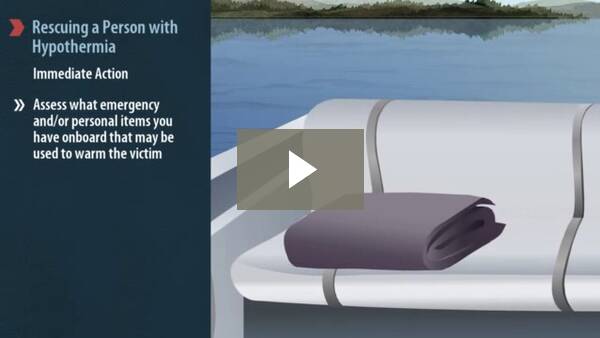Hypothermia
If suffering a person is suffering from hypothermia, their core body temperature will drop below normal levels. This results in weakened muscular functions, reduced co-ordination and slow mental functions.
A person suffering from hypothermia will exhibit progressive symptoms including:
Early Stage
- The victim is still conscious
- Shivering
- Slurred speech
Intermediate Stage
- The victim may be irrational, confused and sleepy and will exhibit a lack of co-ordination
- Slow and weak pulse
- Slow breathing
- Shivering will now be slowed or absent
Final Stage
- The victim may lose consciousness
- Weak, irregular or absent pulse
- Weak, irregular or absent breathing
Cold Water and Weather Survival Gear
If you plan to operate in the early spring, late fall or in other cold environments, you and your passengers should always make use of cold weather and cold water protection gear. You can protect yourself by wearing a life jacket or PFD and multiple layers of dry, light clothing and a water or wind proof outer layer.
Gear specifically designed for cold environments offers better protection from the elements and can delay the effects of hypothermia:
- Wet suit: Traps and heats water against the body and should be used with a flotation device.
- Dry suit: Remains dry on the inside and should be used with a flotation device and thermal liner.
- Survival suit: Helps retain body heat and works as a full body flotation device.
- Immersion suit: To be used in extreme conditions when abandoning a vessel.
- Exposure coverall: A PFD with thermal protection.
Be sure to choose cold weather protection gear that is appropriate to the temperature and your planned operating environment. Knowing how your equipment works in the water is also important. Test your equipment in a warm swimming pool or in calm water before you need it in an emergency.
Rescuing a Person with Hypothermia
Immediate actions:
- Ensure that you are wearing an approved PFD or life jacket
- Assess the victim’s current condition: What stage of hypothermia is he/she exhibiting?
- Clearly identify yourself to the person and ask him/her to respond
- Assess what emergency and/or personal items you have onboard that may be used to warm the victim
- Assess your ability to help the victim:
- Do you have warm, dry items to cover and wrap the person?
- Will you be able to get the victim to shore quickly?
- Exhibit a distress signal indicating your need for assistance if necessary
Rescue Procedure
Step 1) Remove the person from the source of cold exposure (you should use the overboard rescue techniques, previously described in order, to remove the person from the water).
Step 2) Dry the victim from head to toe and dress with layers of clothing. Provide dry shelter below deck if possible.
Step 3) Attempt to slowly increase the victim’s core body temperature by one or a combination of the following actions:
- Cover the victim’s head and neck
- Wrap the victim in dry blankets or towels
- Cover the victim with an insulating device (such as a reflective heat blanket) and moisture barrier
Remember:
- If the victim asks for a warm liquid, you may provide it to him/her–you should never give the victim alcohol or hot stimulants
- Do not ruband/or massage the victim’s body or extremities in an attempt to warm them up–doing this may damage nerve endings at the skin and encourage cold blood from the extremities to move to the core of the body
- You can use you own body to transfer heat to the victim
- You should always carry a safety kit including equipment suitable for cold water and cold weather emergencies





